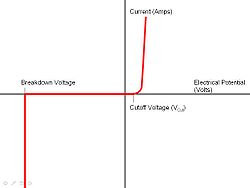Jie's Current Introduction
Light is made up of small packets of energy called photons, so small, in fact, that they are almost impossible to measure directly. The amount of energy that is deposited when one photon of wavelength is absorbed is equal to , where is Planck's constant. For example, a candle puts out photons per second. The human eye is not able to detect individual photons; even a light pulse of one million visible photons would not be bright enough to be seen. This is not a problem in everyday life because normal light levels are much higher than this. However there are some situations where detection of very low levels of light is required. Examples include viewing distant objects through a telescope, or imaging a tumor in the human body using a PET scanner. Both of these applications require cameras with single-photon sensitivity.
The standard technology for such detectors, originally developed for atomic and nuclear physics experiments, is based on the photomultiplier vacuum tube. Particle physics experiments have relied on photomultiplier tubes for over 40 years. Ever since the invention of the transistor, efforts have been made to create semiconductor-based photon detectors, but certain drawbacks have limited their use to a few niche applications. Recently, however, progress has been made toward the goal of creating silicon-based detectors with single-photon sensitivity that can operate at room temperature. These devices are called silicon photomultipliers.
Silicon photomultipliers use semiconductor technology to detect single photons at room temperature. A semiconductor is a material with an electrical conductivity between that of a conductor and an insulator. The electrical conductivity of a substance measures how much electric current flows when a given electrical potential is placed across it. A perfect insulator has an electrical conductivity of 0, indicating that no current flows through it even when an electrical difference is present. A semiconductor normally acts like an insulator up to certain potential difference, called the breakdown voltage, above which it becomes conducting. The vast majority of electrical devices today make use of semiconductors. One very common electrical component of semiconductor electroics is the diode. A diode is like a valve for electric current, that conducts current in one direction, but not the other. (See Image 1 for more information)
As with any electrical device, when the electrical potential is 0, there is no current flowing. Even at very small electrical potentials in the forward direction, no current flows in a diode. A diode only begins to act like a conductor once it reaches a cutoff voltage(). Upon reaching that cutoff voltage, the semiconductor begins to act like a conductor, causing the amount of current to increase very quickly. When an electrical potential is placed across a diode in the reverse direction, the diode prevents all current from flowing until a certain breakdown voltage. At that breakdown voltage, the diode is no longer able to hold back the electrical potential and spontaneously breaks down, becoming a conductor, no longer resisting current flow. This results in a sharp spike of current in the reverse direction. The breakdown voltage is much larger than the cutoff voltage.
Photodiodes produce a single electron from each photon that hits the detector area. But since physicists are trying to detect single photons, that is not nearly enough. They had to create a device that releases many electrons for every single photon that hits the detector. (Discussion on PMT?) They could do just that with the avalanche photodiode. Diodes only allow electricity to flow one way. So if voltage is applied in the opposite direction of the way that the electrons were meant to flow, no electricity would cross. Yet every single diode has a breaking point. If enough voltage, or electrical force, is put across a diode, it could suddenly allow all the electricity through, like a dam breaking. The voltage that is applied in the reverse direction is called reverse bias voltage. Physicists take advantage of that effect by applying enough reverse bias voltage that the Avalanche photodiode that anything, even the energy from a single photon is sufficient to cause it to break down. This is called the breakdown voltage. If a photon were to hit this diode, it would cause a huge surge of electricity to go through the diode and therefore the entire curcuit, one that could be measured by the scientist.
Normally, when a diode breaks down, it allows all the electricity to go through, causing it to heat up immediatly and burn up in an instant. But in the interests of preserving the photodiode for reuse, a resister is introduced in the circuit. This resister limits the amount of aperage, or the number of electrons from going through the circuit, and therefore prevents the photodiode from burning up.
Once the current is limited by the resister, the voltage drops below the breakdown voltage and the diode again starts to restrict the flow of electrons and the diode resets. (don’t know how to explain the capacitor)
A new innovation that scientists have developed is the SiPM. It is a photon detector that is an array of avalanche photodiodes. ***(Should I even mention the SiPM? Since dark rate works the same way with the Avalanche photodiode and the SiPM)
The photon detector's sensitivity also poses
It is primarily determind by the band gap of a substance. The band gap is the distance that an electron must travel before it goes into the conduction band. Smaller band gaps would equal a higher electrical conductivity. Semiconductors can be used to detect single photons because of their sensitivity to electrical fields.





